#the foreshadowing was masterfully executed
Explore tagged Tumblr posts
Text
I'm really happy to see Sousou no Frieren gaining popularity. It means that there will be more people I can share the experience of The Macht Arc with.
I'm pretty sure the anime hasn't gotten there yet, because the screaming has not reached my dash through osmosis, but I look forward to the day when it does.
That arc changed me. I can never look at lighting a cigarette the same way. The phrase "partner in crime" will never be the same to me. I love the bastard & bastard action, and above all, Frieren's Clarity of Purpose underneath all her antics and eccentricities.
It's a wonderful experience when you resonate with all the characters involved in a complicated conflict and they're all extremely well-written and the foreshadowing is powerful but the story could still go one of several ways, and no matter how it goes, you know it will hurt.
It did hurt. I loved it.
I can't wait to see other people screaming and crying over it as well. We can all be in pain together =)
#sousou no frieren#I don't follow the fandom tags and really can't be bothered to keep up with it#but the Macht Arc was definitely one of the most intense emotional experiences I've had in fiction#right up there with The Grapes of Wrath tbh but significantly less politically eye-opening#not that Frieren being less political or less relevant to real life is bad!#the foreshadowing was masterfully executed#the returning motifs were icing on the cake#I'm in agony now and forever. My hat is off to the author
14 notes
·
View notes
Text
will always be obsessed with how ray is written in the first episode of tpn because he's just so. detached from the idyllic, happy narrative the other kids are living in. he's reserved and quiet, curling up under a tree with a book while everyone else laughs and plays around him. he rarely speaks, and he almost never does it without being directly addressed first. he's the only one who seems to question isabella's authority in any way ('she says that, but it's not even true.') the absolutely loaded interaction between him and emma at the fence, 'mh-hm. you really love mom, don't you.' 'well of course i do! everyone does!'. the way all the kids talk about their big dreams for when they leave gracefield while ray simply says he'd have to 'learn to survive first'. the quiet ‘happy, huh?’ when emma talks about how good their lives there are. the way the camera shifts between everyone's smiling faces while conny talks about her dreams for the future before getting to ray, who just looks hurt. he’s a direct contrast to all the other children who love their lives and one of the biggest indicators that there's something going on with gracefield underneath the surface. something is wrong, and this kid knows it. i just love it so so much
#skye's ramblings#UGH ITS JUST. ITS SO SO GOOD#i adore this episode especially compared to the manga they added so many little details and interactions that drive me insane#the foreshadowing in s1 is literally masterfully executed i have rewatched countless times n i still notice things n go >:O#its so. so fucking good
45 notes
·
View notes
Note
do you have a favourite RWBY arc?
Hello anon!
Do you mean story-arc or character arc? I am just gonna go with character arcs because I feel like it :) Here is my list. It combines my personal taste with those I think are best written.
1- Penny Polendina

Penny's arc is the best complete one in the series so far. It is thightly written and very powerful. Her final choice does what every character arc's climax should do: it ties togetyher all the thematic threads explored by Penny's arc in one incredibly meaningful moment. In the end, Penny chooses to be a friend, shows she is an adult and affirms her own humanity. Her choice is meant to be tragic and bittersweet because humanity can be both. Still, it is definately worth it.
1 - Cinder Fall
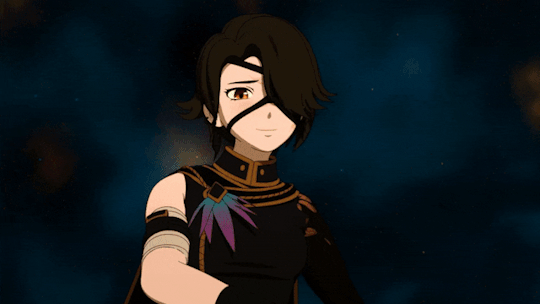
Cinder's arc isn't complete, but there is already enough for her to get first place together with Penny. Midnight is the best written episode of the series in my opinion and it manages to tie together all the pieces of foreshadowing and subtext present in Cinder's story up until that point. It is also a pivotal point in Cinder's story, where she has to make a choice. Will she recognize she is still a prisoner of abuse or will she ignore this truth? She chooses to repress and fails to develop positively. As a result, she has prepared her own tragedy.
Cinder's story is key to the whole series and it has the potential to end up above all the other arcs, if well executed.
3 - Weiss Schnee and Yang Xiaolong

Ice Girl and Fire Girl are tied for third place! (together with Jaune)
Weiss's arc has a very strong set-up and beginning. She gets a lot of focus at Beacon and quickly develops. After such a solid start her development can take the time to happen slowly, so that we can see how she has silently and beautifully evolved throughout the volumes. She is now warmer, kinder and happier than ever. Points for her having some of my favourite motifs.
Yang's arc is kind of the opposite, in my opinion. She gets the least focus among the 4 main girls in Vale. Still, the moment her arc decides to roll, it gets central stage. Her focus in Mistral is wonderful and her development is beautifully conveyed in volume 5 and volume 6 climaxes. Her confrontation with Raven is especially one of the best scenes of the series.
3 - Jaune D'Arc

Jaune's arc is one of the best executed both in terms of pacing and evolution of the character. If he keeps going this way, he might climb to first place tbh.
6 - Ruby Rose
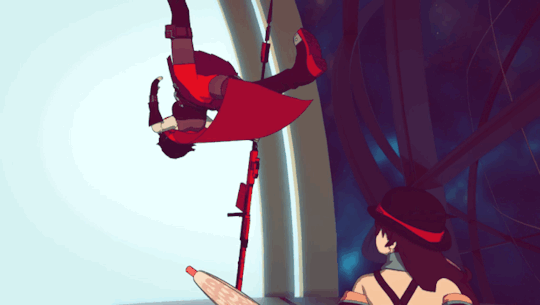
I am expecting her to climb higher. Her focus in volume 9 was great and a beautiful first step in her development. The choice to mask her LRRH's story behind Alice in Wonderland references was wonderful and brilliantly executed. I think the ending could have been conveyed more powerfully, but the final result is still great. I am looking forward to how her arc will continue!
7 - Blake Belladonna and Oscar Pine

Blake's arc is beautiful and it ties together many thematic threads. Maybe a little bit too much, which is why it is below the other main characters. She is still wonderful though! And the more one analyzes her story, the more gems are found!
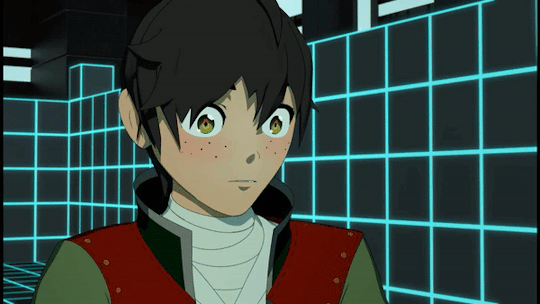
Oscar is one of the best written characters in my opinion, as his story is thight and perfectly intertwined with the main plot. Still, I think it has still to enter its climax, hence why he is only 7th place. Totally expecting him to climb higher, though.
9 - Emerald Sustrai

Emerald's arc has still to climax, but I like her set-up a lot and she is slowly going through a beautiful inner growth. There is already enough meet and actual development for her to just make the top 10 :P
9 - Pyrrha Nikos and James Ironwood
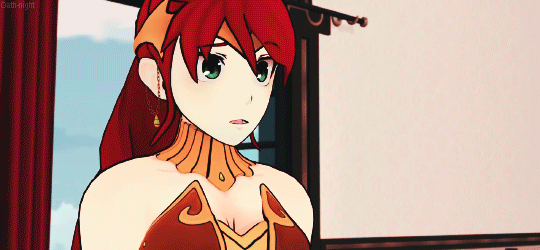

Both have masterfully written arcs and in terms of writing they could be higher. Still, I am less involved in their stories compared to others. In any case, they are two perfectly executed examples of tragedies. And different kinds of tragedies, as well.
Pyrrha's tragedy lies in the world around her. Ironwood's tragedy lies within himself.
11 - Lie Ren and Qrow Branwen
Both Ren and Qrow have beautiful arcs, but I am less involved with them when compared to others. So, here they are.
I would highlight this list doesn't consider characters like Salem, Nora, Raven, Summer or Mercury because even if set-up, their arcs still need to properly happen on-screen. Among them, though, I would say that Raven and Mercury especially have wonderful set-ups.

Raven's characterization and focus in volume 5 makes her one of the best written characters tbh. She is despicable, flawed, a coward and a hypocrite. And this is precisely why she is so great. She is very human and layered. It is clear she cares about Yang. Still, it is also clear she is too selfish and scared to act on her feelings. The way the narrative peels away her powerful mask to reveal a weak soul behind it is great. As it is the challenge for her to overcome her fear and make amends.

Mercury has so far one of the best set-up arc. His writing has been extremely thight and almost every scene he is in gives additioinal information on him, his background, his bonds with others and his feelings. All in a very subtle way. Basically, his writing is very rich and we can infer a lot, despite his arc having yet to start. He is the embodyment of the cycle of abuse and I am curious to see how this concept gets explored.
Finally, shout outs to Neo and Ilia. Their arcs aren't as complex or long and have less bits than the main characters'. Still, they are thight and perfectly executed.
Thank you for the ask!
#rwby#rwby chain of faves#asksfullofsugar#anonymous#penny polendina#cinder fall#weiss schnee#yang xiao long#jaune arc#ruby rose#blake belladonna#oscar pine#emerald sustrai#pyrrha nikos#james ironwood#raven branwen#mercury black
34 notes
·
View notes
Text
while i agree that not knowing the twists and turns of Gravity Falls made for an awesome first time viewing experience I disagree with posts lamenting the fact that people are losing something if they already know of Bill Cipher or Ford or Weirdmaggedon
like bro plenty of classic media has its spoilers and vibes disseminated through cultural osmosis but we still love and watch them with new audiences all the time.
the spoiler might make something less surprising but what really matters is the execution and Gravity Falls masterfully executed foreshadowing and mystery writing like I'd never really seen in a kids show before
plus, just knowing vague things like the author's identity doesnt detract from the million other things most people couldnt possibly know on their first watch. let em go in with some foreknowledge it's fine it's fiiiiine they'll still have a good time
6 notes
·
View notes
Note
Is the hundred year old playlist worth it?
Hello stranger!
You guys sure do love asking me about THYP, huh? Not that I mind. I've talked about my love for this series several times in the past, and I'll gladly do it again. So, short answer to your question: Yes, it's worth it.
Longer answer (because I simply can't help myself): Also yes.
Is it perfect? No, but what is? Are there maybe certain characters, relationships, situations in this 300K(!) series that I wish had been handled differently? Sure. But (1) the author didn’t write this for me and to satisfy every single one of my personal preferences and headcanons and (2) in light of the epic scope of this series, I’m willing to overlook some gripes I have (so magnanimous of me, I know!). Because the good parts? Are really fucking good. And there are so, so many of them. There’s also a creative confidence and a technical skill to the writing and in the way this series is structured that is just a delight to read.
At any given point in the story, you can feel that this is an author who was On Fire, on A Mission, who had A Plan, and who executed that plan masterfully. Whether or not that's actually true doesn't matter. Maybe it was a disaster behind the scenes, who knows, the point is, you can't tell. To give you just one example, the way the author uses flashbacks and foreshadowing (and the way she pays it off!) throughout the series is absolutely fantastic—all while working within the confines of a very inconsistent and often downright contradictory canon. Also, and without spoiling it, the "finally-getting-together" scene in this remains one of my all-time faves to this day, and after a build-up of 5½ parts and hundreds of thousands of words my expectations were sky-high. Somehow, the author managed to not only meet them but surpass them.
If you're worried about the series' incomplete status—don't be. The last part (pre-IW) ends in a very, very satisfying place. In fact, the very last scene is as close to perfection as it gets and I still remember reading it for the first time and how my heart nearly exploded with joy and hopefulness, even while I was bawling my eyes out at the bittersweetness of it all.
But that's my opinion. In the end, I cannot tell you if it’s worth it for you. I can only say, yes, definitely give it a try. There’s no rule that states once you get started you must finish it. If you find the slow burn is too slow for you or there are things in it that you simply don’t like, you can always just stop and find something that is more to your taste. After all, that's the beauty of Stucky fanfic. There's so much and such a great variety of it that sooner or later you will find something that is perfect for you.
#asks#stucky fic rec#musings of a fanfic reader#also and i don't mean for this to sound condescending at all but if there are certain characters and ships you *absolutely* cannot stand:#reading the tags should help you make a somewhat informed decision i think
9 notes
·
View notes
Text
365 Albums in 365 Days: 95/365

Date: Friday April 5th Album: newave Artist: Coaltar of the Deepers Released: 2002 Genre: Shoegaze Review: If you have listened to shoegaze in any capacity you’ve almost certainly been told that sweet voyage is the best closer to any album ever produced— and well… yeah. it is. The energy is absolutely infectious, the flipping between moods and soundscapes executed masterfully, and it’s even foreshadowing in its chaos by the songs before it. Newave is an album that tries to be 20 things at once— and actually somehow succeeds. Everything is disparate but completes coherent, forming an impossibly expanse final product with an undeniable identity despite it all. This band goes crazy. Favorite Track: sweet voyage
5 notes
·
View notes
Text
Gallant
Written by V.E. Schwab
Narrated by Julian Rhind-Tutt

Genre or category
Horror
Target Age Group
13-17 years ; 8th-9th grade
Summary
All Olivia Prior has of her mother is a journal of half-mad entries warning her to never go to Gallant. However, it seems that Gallant is the only possibility she has of finding a home, a family, and some answers. Olivia must learn the secrets of Gallant and the immense burden that it has placed on the Prior family to keep the doors between life and death closed.
Justification
Choosing Gallant was both a continuation of my goal to read all of the Arkansas Teen Choice nominees for the year and also a part of my effort to read outside of my typical genre. Horror is not typically a genre that I pick up naturally, but I have noticed that it is a genre that is checked out frequently in my library. The teens that I work with are all very into the spooky, twistiness of horror books, and I wanted to understand that better. Gallant is somewhat of a middle ground. It’s horror for younger teens and dips its toes into the genre tropes and structure without becoming overly reliant on shock value. I think this book is a good entry point for adults trying to understand the more grim preferences of their teens.
Evaluation
For this review, I will be evaluating the pacing, the ending, and the audiobook format.
Pacing
The pacing of Gallant was a little odd though it had a major payoff in the end. The beginning of the book, where readers are learning about the characters and setting, lasts for about half the book. Because parts one through three have the meticulous job of setting up the twists and turns at the end, it moves a little slower and can feel detail-heavy in places. Schwab does a wonderful job of cutting through the bogginess of the beginning by including small passages between characters that step out of the building of the plot and straight into the thick of it. Schwab uses both excerpts from Olivia’s mother’s diary and small passages from the point of view of the “Master” to weave chapters together and give the readers enough foreshadowing to keep them reading. The pacing increases tremendously after the first half, and the plot is only successful because it was so carefully crafted in the beginning. While the slowness of the first half could turn away reluctant readers, Schwab did effectively bait the more patient reader with just enough tension to carry them through the awkward pacing.
Ending
The ending of the story matches perfectly with the tone and genre of Gallant. Gallant lies somewhere between a dark fantasy and a horror book, and while it is interesting has a solemn and grave undertone to it. The ending, therefore, needed to match the atmosphere that it had created; the ending is not what I would consider satisfying or complete, but that is the point. To end the book with everything saved and perfect would be a disservice to the balance that Schwab establishes in the story. The ending gives the feeling that things are better than before, but only for a while. Teen readers will appreciate the open-endedness of the conclusion and feel a sense of uneasy, temporary resolution that honors the horror genre that Gallant experiments with. The ending would not work in any other book, but it is the only ending that works for this book, and Schwab executed a non-ending masterfully.
Audiobook Format
This is the book that I chose to listen to as an audiobook, though in total transparency I followed along in the physical book quite a bit in the beginning. In the case of this book, the narration of the audiobook is an excellent supplement to the novel but struggles to perfectly replace the physical copy. While readers, or listeners, can follow the plot of the story through the audiobook version, they do miss out on some key details that make the book unique. For example, the physical book has many illustrations beginning and ending chapters, however, they are not just there to add to the aesthetic. We learn that these drawings are one side of the conversation between two characters, and without viewing the art in the book, listeners only experience one half of the conversation. The line between the present action and the journal entries are also a little blurry without the added visuals of the book. That is not to say that the audiobook does not add something to the story that the novel version does not. The intensity of the narrator’s voice adds heightened tension to the plot and creates an eerie atmosphere that a reader might not create on their own. While the audiobook can stand alone it does not feel as complete and fluid as the physical book does, which is something I normally don’t see in audiobooks.
References
Schwab, V.E. (2022). Gallant. Greenwillow Books.
Schwab, V.E. (2022). Gallant. (J. Rhind-Tutt, Narr.) [audiobook]. Greenwillow Books.
0 notes
Note
Your chapter three reveal of the actual cause of King Cold's death was so masterfully executed. Like oh my god, it was done so perfectly. the foreshadowing, the relationship between him and Frieza, you really killed it. 😉
Bahaha. Thanks, just wait until you find out about Frigid's Death, it's pretty well thought out too.
In canon, King Cold loved Frieza, and I thought to say "Maybe don't stop at him showing the favoritism?"
Oh trust me, honey. Trust me, everyone (But Frigid) lived in fear of the tyrant, King Cold especially.
Sadly, he believed the only way to escape it was by ending himself.
I am glad you liked it! :D
Psst, if y'all want to, feel free to send in asks and ping me for fanart of this series.
#dbz#forever and ever series#forever and ever fan ask#asked and answered#answered ask#forever and ever | out of series#forever and ever series mail#dbz frieza#dbz frieza family#dragon ball#dbz fanfic related#. 💞 ; txt
1 note
·
View note
Text
A Silent Voice

For A Silent Voice, I had no previous knowledge of the anime, so it was interesting to see the story develop. As a film, I was most intrigued by the wide array of characters, as well as their development over the course of the story. In terms of the moral and lesson, I thought the sense of societal exclusion and neglectfulness of some of those in power were strong devices to express the story’s themes of friendship and to love yourself.
In A Silent Voice, those in power, such as the teacher when Shoya and the other classmates are bullying and teasing Shouko, do not express the authority and discipline one would expect. This leads to a sense of neglect in providing the proper learning environment for Shouko, who is deaf. Eventually, the bullying and teasing of Shouko reaches a point to where Shoya experiences the societal exclusion Shouko felt and later on he desires to make amends.
As the story progresses, Shoya and Shouko aim to repair their elementary school friendships. However, as time progresses, it becomes apparent Shouko has a very poor personal view of herself, to which Shoya cures in the climax. As a film, the form of foreshadowing of Shouko’s near tragic end was also masterfully executed through Yuzuru’s photographs.
Another area of the story I found intriguing is the symbolism of the X-marks on people’s heads and how one re-appeared on Naoka after Shoya’s childhood trauma of Kazuki, since the use of X- marks evoked an easy-to-interpret metaphor on personal insecurity and how you see others around you.
However, the biggest message to take from the film is to live life to the fullest and love both yourself and your unique aspects of yourself, instead of seeing yourself as a burden or to be unfit in society.
0 notes
Text
THE SHINNING

The Shining is a heart pounding movie that keeps viewers on the edge of their seats. But there’s one specific scene I’d like to talk about that plays a crucial role in the storyline, adding to the overall suspense and terror. As the characters navigate through and builds the tension, leaving the audience captivated and anxious for what lies ahead.

The snow maze is a visually striking setting in this film. The towering walls of snow create a sense of isolation and entrapment, amplifying the feeling of claustrophobia. The vastness of the maze is intimidating, as the characters struggle to find their way out. The contrast between the pure white snow and the darkness surrounding the maze adds to the eerie atmosphere.

This scene also shows a lot of Symbolism and Foreshadowing like for example: the snow maze holds deeper symbolism within the context of The Shining. It represents the psychological maze that the characters find themselves trapped in, mirroring their descent into madness. It serves as a metaphor for the labyrinth of their minds, filled with uncertainty and hidden dangers. Additionally, the scene foreshadows the challenges and horrors that the characters will face as they confront their deepest fears.
The sound design in the snow maze scene is masterfully executed to heighten the sense of suspense. The absence of music creates an unsettling silence, allowing the audience to focus on the natural sounds within the maze. The crunching of footsteps in the snow and the characters' heavy breathing intensify the tension, making the scene even more nerve wrecking. The atmospheric immerses the viewers in the chilling reality of the characters shoes.

This scene has a profound impact on the characters and their psychological states. As they navigate through the maze, their sanity is tested, and their true nature is revealed. The maze becomes a physical manifestation of their inner demons, pushing them to the brink of madness. This psychological journey adds depth to the characters and contributes to the underlying themes of the film, exploring how fragile the human mind really is.
1 note
·
View note
Text
Obi-Wan Kenobi show Episode 3 thoughts
Some people seemed to like reading the Episode 1-2 thoughts I put up last week, so here are some Ep 3 thoughts before Ep 4!
Spoilers for Episode 3 of the Obi-Wan Kenobi show beneath cut.
Gosh what an intense, RAW, powerful episode. Many parts of this episode just blew my mind, and I had to watch it a few times to truly process it.
Starting with the biggest thing: Obi-Wan and Anakin/Vader's reunion.
I am genuinely shocked I'm saying this, but I think it was handled masterfully, far better than I expected.
First, it starts with buildup. We ended on an amazing cliff hanger in Ep 2, and the recap flows seamlessly into unmasked clearly-Hayden Vader getting dressed. We see for the first time all of the details entailed in putting on Vader's suit--the heavy chains, the darkness, the attachment of all four metal limbs, the freakin' NEEDLES that stab into him that had me cringing away from the screen at how horribly painful it looks. It is not a smooth, graceful transformation. It is heavy, coldly mechanical without a single other life form involved. It's clearly painful, and it's part of the daily suffering that Vader has experienced every day since, in his mind, Obi-Wan left him like this.
It's almost jarring when he then strides out at a brisk walk, looking very must like the Vader we saw in the OT, even with James Earl Jones's voice...! But the opening ensured that we know exactly who is under that suit and how he got there. It tells us, without words, exactly how much he's reminded of Obi-Wan every day, and how much he hungers to find him again.
Then on Obi-Wan's side, the buildup was masterful too. Now that he knows Vader is alive, Obi-Wan knows without a doubt that Vader will come for him. His He is coming to Qui-Gon was fucking chilling. Then that damn ghost-vision-apparition he sees of Anakin in the field--that I had to do a double take to see, but no, there he is, Episode 3 Anakin in the flesh...! except not. It was done so well, making us unsure whether it was a stranger, the realization we recognize that color robe, that shape, then the glimpse of Hayden's face--we realize he can't be there, he must be a Force-vision foreshadowing or Obi-Wan hallucinating or something but we don't know, and I think we get clearly that he doesn't know either. It's not even clear if it's pre-fall Anakin, or Vader before he was burned, and again, I don't think Obi-Wan knows either, more on this later. Just, the overall subtle horror-movie vibe, of a first glimpse of a bad omen, and just the whole execution was absolutely chilling, absolutely beautiful.
Then we get to their actual reunion and--their bond. I feel like the exact nature of the bond between Jedi hasn't really been consistent in official media, and fandom interpretations have definitely taken and ran with it. I almost feel like what we saw, with Obi-Wan reeling and feeling, intensely and enough to physically affect him, almost leans more towards fandom interpretation, to what I wanted to see but did not expect to see. The fact that Obi-Wan knew immediately who was coming, but had to see with his own eyes, could not be torn away, drawn by a Force stronger than any logic or self-preservation could counter. He was utterly helpless as he watched Vader terrorize the villagers, and he knew Vader would be just as drawn to him.
Obi-Wan would usually never leave Leia, but in this situation, he has absolutely no choice. He knows that at this proximity, no matter where he goes, Vader--Anakin, in his mind--will know exactly where he is, their bond, once made of love but no longer, pulling them towards each other. He has no choice but to entrust Leia to Tala, because if he stayed with her, he's guaranteed to lead Vader to Leia.
The scene in the hills really manifests that Horror Movie feel. We know that Vader is supposed to be terrifying, but this absolutely sells it. When Ewan said in an earlier interview that Vader terrified him, I just sorta smiled, but man after this I understood. The moment of silence before he ignited his saber--I knew what was coming but cinematically, it still gave me chills. If ever there was to be a confrontation between Vader and Obi-Wan, and if ever Vader was to draw his saber--this is the impact it needed to have, and it delivered.
Hayden in that suit is MASSIVE, and his blows are heavy, unstoppable. Obi-Wan is utterly unprepared, both physically and emotionally. He told Bail it's been ten years, and he meant it. Some low-life child-kidnappers managed to land hits on him. He's beyond rusty. And the revelation that Vader/Anakin is alive, followed immediately by his actual arrival before Obi-Wan has time to process any of it--he's utterly mentally unprepared too.
Obi-Wan's saber, drawn. The blue and red lightsabers in the darkness. The buttons of Vader's suit glowing in the shadows. It was all done so masterfully, I could probably write an essay on the color/lighting in this scene alone.
And then the Revenge Fire. It was brutal. It was more brutal than I was expecting, but it's also exactly what Vader would do. He would want Obi-Wan to suffer, long and drawn out. After ten years, he wouldn't be satisfied with a quick death. It horrified me, but also made so much damn sense (though I wondered why Obi-Wan's face/hair/beard conveniently did not suffer any damage lmao).
But then the part that made me go hmm--Tala's shot makes the flames rise up, the NED-B scoops him up, and for all points and purposes they get appear to get away. I completely understand why the stormtroopers weren't able to get through, but Vader should have been able to lift Obi-Wan with the Force and simply pull him through the flames.
But he didn't.
I know people are hoping for a Clone Wars flashback in the next episode, now that Obi-Wan is unconscious, and man I'm praying for that too. But it's Vader's inaction at the end here that makes me think that Obi-Wan isn't the only one who was shaken and taken off-guard by their sudden and violent reunion. I am so intensely curious what was going on in his head as much as Obi-Wan's!
Other random points:
When the cargo ship was first pulling up on Mapuzo, the planet they're on for the episode, the music made me wonder if Hondo was gonna show up--in other words, I thought it was a bop ahahaha. Alas, Hondo did not show up, but there's still hope!
Leia. The fact that she "does not talk" but immediately starts talking leaving Obi-Wan to be the mumbler. How confident an orator she is, the way she doesn't panic even when she stumbles and almost says friend instead of father. The fact that ironically enough, it's Obi-Wan who slips and calls her Leia instead of Luma, a name that he'd provided. All of this points to how both distracted and rusty Obi-Wan is, but also makes me think that he's being reminded so much of Padmé every time Leia opens her mouth. That bit where he tries to cover his miss by saying Leia reminds him of her mother--it was heart-wrenching, but a beautifully written piece of dialogue, that truly honors Padmé and her memory.
A tangent, but I have to mention it: I absolutely love how this show has been handling Padmé references. Tbh, I wasn't expecting any, maybe one, because Padmé has been very neglected in general by the post-prequels franchise. But gosh. Both Obi-Wan's mention of her in Ep 2, and the scene above in Ep 3--it all shows how Obi-Wan remembers her, and possibly most importantly, not as an add-on to Anakin, but as an individual. He doesn't remember her as Anakin's lover or crush. He remembers her leadership, her bravery, her charisma, her confidence. He remembers her as his friend, someone who, again, he saw through her final moments. That is immensely meaningful, and more than I frankly ever expected from any Star Wars live action.
Back to Leia, but she is so sharp. She knows Obi-Wan is hiding something, and immediately pinpoints that there's something in the way he spoke of her mother. We, the audience, definitely felt something, but it was still surprising to see her zoom in on it, but not unwelcome. She then goes on to ask if Obi-Wan is her father, again a very logical question to ask in this context, and that leads back to Anakin and pain. Obi-Wan's answer of if only I was (or whatever his exact words were) was so filled with regret, his attention once more on Anakin.
In sharp contrast to these beautifully quiet but meaningful character moments, this episode was also extremely violent, in a visceral way too, that made me shocked D-mouse even allowed it. The Stormtrooper cut clean in half with several very visible shots of the cut. Vader freakin' snapping a child's neck. Dragging a woman as she screams horribly. It was awful. It was real. It was exactly the amount of horrifying that I would expect from Vader, but did not expect to see in live action. To be clear I am not at all complaining, I was glad to see it, just shocked!
Another neat thing: I absolutely loved this show showing us the nitty gritty details of How Things Work, that had always existed in SW but we just haven't had the chance to explore in this much depth. I know I mentioned Vader's suit-up scene above, but also the launching of the probe droids. We're very familiar with those droids, but how they're just shot out like that? Fascinating. I absolutely love how these moments fill in details about familiar things, helping us understand them and the SW Universe more.
The Inquisitor Island design was absolutely killer. I loved the scene of Reva walking through, of just how massive it is on the inside with sinister ceilings and arches and pillars. It almost looked more Middle-Earth/high fantasy than Star Wars, and the merging of that ancient, dark-mystical aesthetic with sci-fi Star Wars with all the stormtroopers and officers walking around and the lightup doorways and such--chef's kiss.
I think I liked Reva considerably more in this episode than I did in the first two eps. I won't quite say she's growing on me, but I'm seeing more potential for her character. I wasn't a fan of the Inquisitors squabbling, but that's pretty consistent with Rebels so I'm not surprised. As I noted in my first ramble, I think Moses has a phenomenal aura, and boy did I feel it in this episode. There's one scene in particular when she's in the hidden room and sees the Jedi order symbol where she looks like she's about to cry, and there's such longing(?) or some other unreadable but complex emotion, and I'm fascinated by that moment. Given how Tala talked specifically about how Force-sensitive children are taken away, I'm getting more confident that she not only was talking about Leia, but was foreshadowing the reveal of Reva's past. I'm very curious indeed what will happen with Reva + Leia in the next episode.
I will say though, that with Reva's goal made clear, it definitely makes me concerned about the fate of her character. She stabbed and incapacitated the Grand Inquisitor, who definitely knows she did it. Said Grand Inquisitor is still alive, and we know that he retains his position given that Rebels takes place after this show. I highly doubt he'd let Reva go after what she did to him, so once he wakes up, it's sorta game over for Reva, unless she does something significant that gets her either Vader or the Emperor's personal protection. I feel like the likely scenarios are 1) she dies, 2) she defects (possibly thanks to Leia). I'm praying for the latter, but that will depend heavily on her past and what lead her to have her current motives, so we shall see.
Lastly, the two references that absolutely made me scream in this episode:
QUINLAN VOS. He was definitely up there in my list of character I'd love to see appear in the Kenobi show, but i didn't seriously expect it, at all. So when his name came up, it was like a punch to the gut (and of course I had to draw him immediately haha). While Obi-Wan has referred to Quinlan as "General Vos" in Ep 3, and of course there are the clone wars eps, the way he just says Quinlan here--someone survived, someone he knows, his friend survived and is still out there doing good--it was incredible. It was so much more than Obi-Wan expected, and so much more than I expected of this show. (praying this means there's hope for a Quinlan spin-off or at least appearance. I stick by my stance that I think a Quinlan-centric live action would be amazing)
JABIIM. Jabiim is the planet that Tala says she's going to send Obi-Wan and Leia to. To those unfamiliar with Legends, it's just a planet. According to Wookiepedia, it was apparently also came up in some sequels-era thing? But I know it from the Republic (Clone Wars) comics--the place of horrible rain and mud and hopeless endless fighting, where Obi-Wan fought alongside my beloved Alpha-17, and where the two of them were thought killed but were actually taken captive by Ventress to experience one of the most traumatizing events Obi-Wan has gone through in any media. Of course, most of that will probably not be relevant to this show, as it's Legends, but the fact that they chose this specific planet to reference still felt like a blow. (I know it won't happen but man. Canonizing Alpha-17 would be wonderful ;_;)
Lastly, I really loved the look of wonder Obi-Wan had at Tala's whole system. At this little piece of Rebellion, that doesn't even call it that, which has already helped so many. Obi-Wan's realization that there are others--that his meeting with Nari wasn't a one-time occurrence--that he isn't alone, and that people are working together to fight and save each other. I think he had a lot of thoughts, especially at Leia's interest in learning how to fight, which were likely all blown out of his mind by Vader's arrival. But I hope he'll think more on it in the future.
And that's the end of my disjointed unedited ramble! I'd love to hear any thoughts if you had any!
Onwards to Episode 4 in a few hours!
-Posted 6/7/2022, before the airing of Episode 4
41 notes
·
View notes
Text
Finished Season 4 of Castlevania: the Netflix, and thus the whole series! And I’ve got a lot to say!
Here’s the biggest observation for this season: I get the impression that they didn’t originally plan for this to be the final season. It feels like, at the start of Season 3 they believed they were going to have two more seasons, and then maybe by the time they started wrapping that up they were told they’ve been cut down to just one more, so they had to speed of the pace of Season 4 dramatically to make sure they could still hit the ending. I have no actual evidence to support this- I haven’t read any interviews or official comments to that effect- just a gut feeling based on aspects of the plot:
Biggest support of this is how quickly Saint Germaine is just like “ok I’m evil now”. He immediately submits to the random woman who tells him he’s gotta be evil to find his lady love, there’s one scene of him murdering a guy, and then he’s all-in on being a villain, complete with “I AM A GOD WHO FUCKS” monologuing.
In addition to Saint Germaine’s heel turn feeling half-baked, the Dracula’s resurrection plot in general really doesn’t feel all that important until the finale. Varney is a comic relief character, which in hindsight was completely intentional, but Ratko and Draken are just huge fighter dudes who weren’t involved with Dracula’s court during Season 2, but are very into bringing him back for reasons that are never clearly explained besides the assumed “it’s Dracula so we gotta”. Additionally, the way major characters like Hector and especially Isaac treat the resurrection plot don’t help, although it makes perfect sense that they both do what they do.
The things that happen in Targoviste, and the way they happen, also contribute, especially because there’s no satisfactory resolution to it. Trevor and Sypha start to help the people organize and rebuild, and then get whisked away to the Underground Court. They barely have time to react to the fucked up shit going on down there before they teleport to the castle to kick off the finale. More time to let hostilities between them and Zamfir bubble up before the reveal of the Underground Court, along with a more satisfying build-up to Trevor collecting the components of the Super Holy Dagger would have been good.
Season 3 ends with Alucard in Hector in very bad places: Alucard has just been betrayed by the twins vampire hunters, which has brought out a misanthropic streak, including him leaving them on pikes, and Hector has once again been duped into an even deeper submission than he was in as Carmilla’s prisoner at the end of Season 2. Trevor and Sypha’s vignettes establish that roughly a month and a half have passed, which was apparently enough time for Alucard to basically get over his trust issues, enough to help the villagers, and Hector to not only cope with the reality of his situation but also finally develop into a character on par with every other major character in terms of competence.
Carmilla and Isaac’s stories didn’t feel rushed like everything else I’ve mentioned, but following the train of thought that there was originally going to be more episodes, both of them could’ve stood to have more time and events to get to their final forms.
So, Death: I don’t know how I feel about Death as portrayed in this series. On the one hand, this interpretation technically not being Dracula’s right hand as he is in the games, and instead being an independent actor that stands to benefit from Dracula’s rampage and thus serves the same capacity as a right hand, is incredible. On the other, the fact that Death’s true personality is actually just Varney fucking blows. The design for Death is also not my favorite, because it reminds me just a bit too much of Castlevania Judgment, but Malcolm McDowell being the voice actor is really cool. In conclusion, Death is a land of contrasts.
On that note, “no it’s not Death Death, it’s an entity that calls itself Death that feeds on death and is an elemental spirit- or force of nature in other words- but is distinctly different from the personification of the concept of-” just fucking say “yeah for all intents and purposes it’s the Grim Reaper”. Coming up with a semantics explanation for why vampires get fucked up by crosses to explain the cross subweapon is fun, don’t undercut your final antagonist by trying to rationalize it into something less fantastical.
I already said that I liked the motivation behind Death, but also the execution of “I’m going to bring back Dracula wrong on purpose” and the way he accomplishes that is the best it’s ever been.
I thought Varney hopping over the stream of holy water was a fun cap on the argument about whether or not vampires can cross over running water from Season 2, but was in fact clever foreshadowing, since Death isn’t a vampire. Good stuff!
I think it’s just because I’ve been focusing a lot on animation quality over the last few months, but I noticed they started using 3D models a lot more this season. I imagine it was a matter of practicality considering that there are more action setpieces in this season than the other three combined. I think this is ultimately a good thing, because they do a very good job of masking the fact that they’re using 3D most of the time because it still looks very good, unlike some of Netflix’s other 3D action projects, and if it makes life easier for the animators without sacrificing quality then that’s a win for everyone.
Didn’t think much of it at first, but I’ve really come to appreciate the term “night creatures” as a catch-all for monsters in this series. It’s generic enough to encompass everything regardless of design difference, but more unique than just ‘monsters’ or ‘demons’.
I had heard someone make a joke about a character wearing Artorias Dark Souls’s armor for a scene because fuck you, but holy shit, Striga really does just wear Artorias Dark Souls’s armor for a scene because fuck you.
When Saint Germaine first shows up, his lines sound really low quality compared to Alucard and Greta, and then that issue goes away after that episode. I imagine that it was pandemic related, but clearly Bill Nighy was either able to get into a studio or eventually got a better home setup- couldn’t you just have him re-record those lines?

I’ve talked so much about how Carmilla’s design in this series is The Best™ because they masterfully adapted a single sprite with no animation from a 1987 video game into a fully realized design, and this frame in particular struck me as perfect. This is the best this character has ever looked and likely will ever look.
I love how optimistic and positive the tone of everyone’s ending is. Ranging from the unexpectedly beautiful and uplifting resolution to Isaac’s story, to the foundation of a town that fundamentally accomplishes what Lisa hoped for at the very beginning of the series, it’s all nice way to go out. Even Lenore choosing to commit suicide, while not necessarily optimistic or positive, is at least on her own terms.
Dracula and Lisa also having a happy ending is nice. It doesn’t really make any sense, and it makes me wonder what Richter’s call to action is going to be in the next series, but I think they were right to have the series end with the same two characters it opened with.
AYY SOMEONE THREW A WINE GLASS!!!
Unfortunately, I’d say Season 4 is the weakest of the series, but they did everything they could to make sure they provided an explosive finale and a solid ending. This was a damn good show and without a doubt the best thing to be associated with Castlevania in over a decade. Not that it had much competition there, but still!
As a final note on the nature of Castlevania as an adaptation: I can certainly understand why certain people don’t like this series. If you’re looking for Castlevania: The Video Game: The Animated Series, you’d walk away disappointed because of how many things were changed in adaptation, how much they were changed, and that so much is just made up from whole cloth. But an animated series isn’t a video game, and while an eight episode series where each episode is a different stage of non-stop fight scenes, complete with a big boss fight at the end sounds like it could be cool, if that’s what I really want I’d probably be better served just playing a game.
9 notes
·
View notes
Text

this is an INCREDIBLY chilling reveal dropped late in the book. it's well-foreshadowed and masterfully executed if you claim humbert didn't kill charlotte youre are actively doing a disservice to nabokovs superb writing AND being deliberately obtuse. or you just straight up can't read, i guess.
need people to stop saying "just because its not WRITTEN that humbert killed charlotte-" like no it is. he did. he absolutely very much did he literally says "i did it" on the page. if anyone wants to argue that he didnt the burden of proof is on them. we are not ceding an inch to the people who read this book with their asshole.
#charlotte haze#humbert humbert#vladimir nabokov#as usual if you dont catch this on your first read#i get it thats fine im not calling anyone dumb for that#its a pattern in the book that these reveals are dropped in tiny asides#but fucking wikipedia or sparknotes DO BETTER
26 notes
·
View notes
Text
Show Review: She-Ra and the Princesses of Power
I went into this show blind with next to no prior knowledge of She-Ra, aside from the name and her apparent connection to He-Man. I found it after browsing through some recommendations for good modern cartoons and have been watching it on-off over this past year.

CONTENT: ★★★★☆
The story of She-Ra progressed from start to finish with clear direction and purpose. Interesting and immersive, it chose to avoid the popular episodic approach where the overarching plot unfolds in the background while minor misadventures take focus. While I do not hate said format, I personally enjoy a constant sense of momentum. The themes tackled within the story felt very current and important to our current global atmosphere, while masterfully kept woven within the presented universe and the setting. However, as amazing as it indeed was, I was not as impressed by how the otherwise imaginative and quirky show approached some particular tropes. Certain plot elements like relationship cracks, redemption arcs and resolutions were, at times, painfully predictable. I find the use of even cliché tropes completely fine by principle but I feel She-Ra could have implemented them in a more clever and appealing manner, instead of having them play out in the exact same way we have seen in other cartoons and animated movies so many times before.
The cast of She-Ra was one of its best aspects. Every character was unique and different from their visual designs to their core personalities, motives and character arcs. In this sense She-Ra has inherited a lot of what once made Steven Universe so good! What I saw was a varied, inclusive mix of delightful personalities and presentations that never once felt forced or slapped-on, but rather meaningful and appreciative of modern day diversity in a way that really helped even such a fantasy world feel that much more alive and dynamic. I’m quite honestly awestruck by how much well even the most minor appearances were handled and how memorable they turned out to be.
The world was vast, imaginative and colorful. Environmental design was eye candy from start to finish and introduced us to a full-fledged fantasy world with its own cultures and kingdoms, even expanding out into the wider universe in a really clever way tied to the overarching story. This show didn’t hold back with magic, including the sometimes jarringly deus-exxy magic of friendship, but for the most part I felt it successfully utilized the concept as a distinct system that stayed true to the rules established for that universe and made it that much more fun to explore.
EXECUTION: ★★★★☆
I partly covered these aspects earlier, but let’s rehearse! As a whole, the show has amazing flow and excellent pacing that keeps you engaged and interested from start to finish. The story has some brilliant foreshadowing, and the way characters develop and sort through their issues feels natural and connected to the bigger picture. The relationship networks are varied, intriguing and complex and dynamic in a way that feels purposeful and consequential. She-Ra is unafraid to bring some very current and important subjects to the table in its meta-commentary while still refraining from coming across as a preachy educational handbook.
As I mentioned before, the clichéd way of presenting plot threads related to some common tropes was my biggest gripe with this show and in the overall execution it caused some of the emotional tension harder to appreciate. Still, even those never felt like a waste of the audience’s time as they resonated well with the rest of the narrative.
VISUALS: ★★★★☆
I’m sure a lot of other people would drop a 5-star bomb for this one. Because let’s be honest, the visuals of this show were gorgeous, the animation was consistent, fluid and played around with fun angles. The character designs were some of the best I have ever seen in a western cartoon and in motion they expressed their emotions beautifully through both facial expressions and body language alike. So WHY ONLY FOUR OUT OF FIVE? I’m not sure I will ever be able to give a western cartoon five out of five. It is mostly down to the small things that can’t be helped without a miracle on the budget side of things, but sometimes the characters look stiff and off model. Sometimes even their movement through the environment looks awkward and unfortunately this occurs most often during those scenes that try to go for a special and innovative angles, reducing the impact and distracting one from the moment. The art style itself also is not my personal favorite, I find it somewhat unoriginal and modern-Disney esque, and I really fail to see the appeal behind certain design choices regardless of how true to the original they are trying to be. I am referring to Catra’s migraine-inducing eyes, and the horrid glowy MS Paint red of Hordak’s palette, to name a couple of these visual turn-offs.
INGENUITY: ★★★★★
This show was a reboot of a very well-known character from many people’s childhood. A such, I am certain I missed some of fun little references and nods and remain unable to judge the show from the angle of a veteran fan. But that’s okay, the show holds its own and serves as a great introduction to the character and world of She-Ra. It tells a strong story with a cast of unforgettable characters, deals with surprisingly deep concepts and dunks you head first in a gorgeous fantasy world you only wish you could visit in person. I went in mostly blind, progressed through 5 whole seasons of story as I kept being positively surprised by all it had to offer, and left the ride satisfied. Satisfied, yet also sad that it is now over... like all good things eventually are.
6 notes
·
View notes
Text
Gochiusa BLOOM episode 3 impressions

Previously: episode 2, episode 1 (seriously, the number of notes on ep 2 review is too low...)
Welcome to another review of Gochuumon wa usagi desu ka? BLOOM. In this episode, the series explores a topic it rarely touched previously, which is school life. Unlike many similar slice-of-life series, Gochiusa rarely concerned itself with such a mundane setting, preferring the ambience of cafés and cobblestone streets. There were a few exceptions, such as the first half of season 2 episode 10, but this is the first episode fully dedicated to a school setting.
Another distinguishing trait of Gochiusa is that the group of main characters attends not one, but several different schools. In particular, there are two high schools: a “normal” one attended by Cocoa and Chiya, and an “elite” one attended by Sharo and Rize. Moreover, there’s a group of middle school characters on the verge of graduating. As such, the question of which high school will Chino, Maya and Megu eventually choose was bound to come to the forefront at some point. And that’s exactly what happens in this episode.
There’s a lot of interesting stuff to discuss, so let’s get down to business...
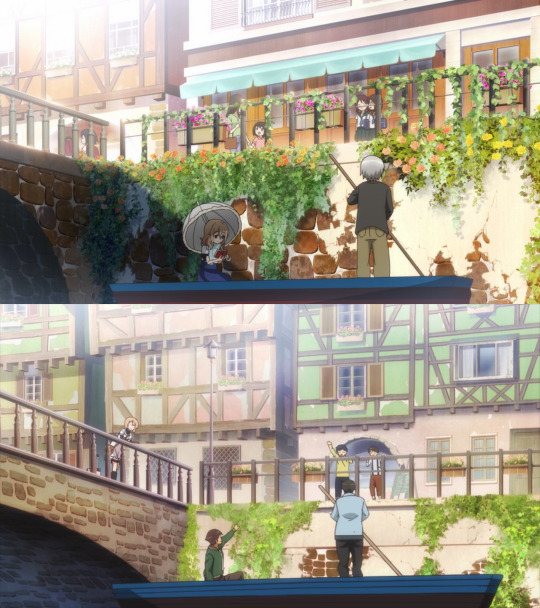
The episode opens with a shot of Aoyama Blue Mountain on a boat, which also appears in the beginning of season 1 episode 1. By the way before COVID you could totally ride a boat like this in Colmar. Just watch your head...

Yeah, this is under the bridge from season 2 ED. Filmed by me.
Anyway, I’m being sidetracked. What’s important is that this is the only shot where you could tell it’s morning, because of the angle of the shadow from the bridge. It is indeed morning, and we see Cocoa and Chino walking down to school. Seems the summer vacation is over and it’s already September? Cocoa, the self-described pikka-pika no onee-chan, tries to coerce Chino into committing to enter the same high school as her, while Chino is not sure about that. We’ve seen Chino being unsure about her future as recently as this season’s episode 1, and in regards to the high school choice the time for a decision is quickly approaching.
Soon we see Maya and Megu who are facing the same decision. Megu seems to have already decided on what Maya derisively calls the gokigenyo school. The greeting gokigenyo (ご機嫌よう) comes from the word “kigen” (機嫌) which means “mood”, and can be literally translated as “how do you do”. However the same word is also used as farewell, which often causes troubles for translators.

The concept of “gokigenyo school“ has been popularised by the light novel and anime series Maria watches over us (Marimite), which is also one of the most influential works of the yuri genre. This concept has also been parodied a number of times, for example in the excellent episode 5 of Flip Flappers.
Megu manages to convince Maya and Chino to come with her to a tour of this school, and we get a close-up of Maya hinting that she’s definitely hiding something.

Meanwhile at Cocoa’s school, the class president declares the theme of the cultural festival being “cafe”, and puts Chiya and Cocoa in charge of it, because they work at a cafe. It seems that Chiya is considered to be more dependable than Cocoa by her classmates, since she got a higher rank. Nevertheless, it is Cocoa who mostly delivers the speech to fire up the other students.
Note the usage of Chinese tally marks to tally the votes. The five strokes comprising the character 正 (”truth”) equate 5 votes. This method is popular across East Asia, even in Korea where Chinese characters are no longer used.

Also I’ve seen a lot of people were confused by the inclusion of “sex museum” as one of the proposals, which is how 秘宝館 (hihokan) has been translated by the official subtitles. This word, which literally means “the hall of hidden treasures” has been used by various establishments of this type in post-war Japan, however only few of them remain open now. I think “sex museum” is a bad translation because, while technically correct, it breaks mimesis, or in simpler terms, immersion. The English translation is so blatantly inappropriate that it would never make it onto this blackboard, whereas the Japanese word is obscure and innocent-looking enough that it just might. A better translation would be “adult museum”, in fact that’s what the most well-known hihokan, Atami Hihokan uses for its English title.
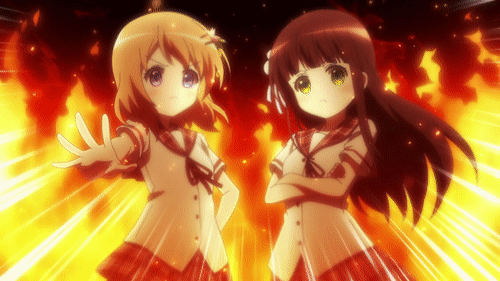
As proof of each other’s ability, Cocoa mentions Chiya’s triple tray wielding skill (お盆三刀流 obon santoryu) which has been demonstrated in season 2 episode 1. Chiya brings up Cocoa’s “basking in the sun” (日向ぼっこ hinatabokko) attitude which supposedly makes her popular among customers. This is a reference to season 2 episode 5 where Rize says Cocoa always either practices latte art or basks in the sun.
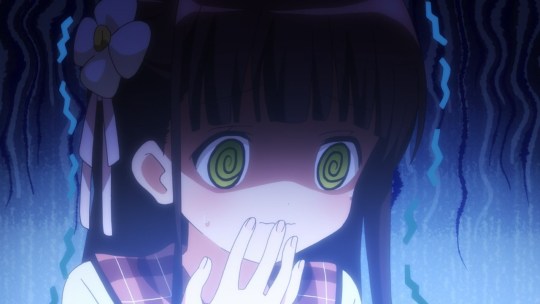
On the way back from school, we learn that Chiya is actually scared of the responsibilities placed on her, and her dream of becoming the president of Ama Usa An franchise (which has been mentioned in s2e1, s2e9 and maybe other episodes I forgot) might be ruined because of this. Cocoa consoles her, again showing her motherly side.
Back at Rabbit House, Cocoa explains how the upcoming festival will be exciting (wakuwaku) and fluffy/cuddly (mofumofu). This is one of several times Cocoa uses silly onomatopoeia to describe something in this episode (aforementioned pikkapika onee-chan and describing her school also as mofumofu in a latter scene). Interestingly, all of these lines are anime-original, and at this point seems like an intentional effort to make Cocoa speak in a more eccentric manner.
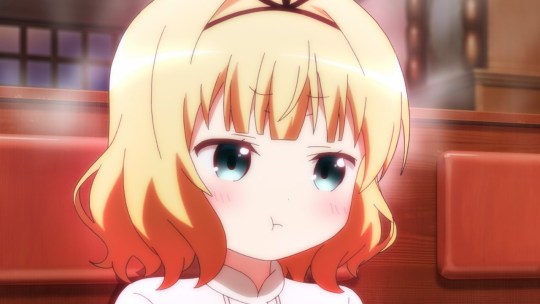
In the next scene Sharo becomes angry at Chiya for keeping secrets from her, and blows her cheeks, which makes her turn into a Fugu fish, according to Chiya. Fugu is famous in Japanese cuisine for being a highly poisonous but sought after delicacy, however in this case the comparison has to do with the tendency of a live fugu (as well as other pufferfish) to inflate its stomach, giving it an almost spherical appearance to deter predators.
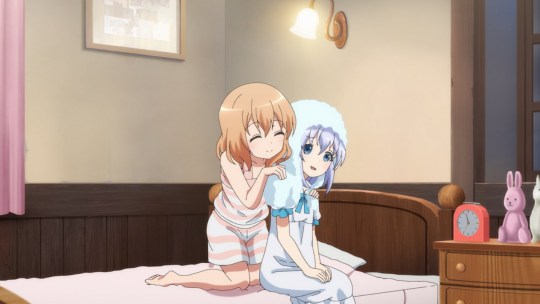
Next there’s another anime-original CocoChino scene where Chino asks Cocoa about what her school is like. This is my favorite part of the episode because it’s just so adorable. Like, even the fact that Cocoa is drying Chino’s hair with a towel after bath shows how close they became. The direction and the delivery of the dialogue is masterfully executed. Cocoa would be really hurt if Chino chooses any other school, and Chino knows that. But Chino can’t admit she’ll choose her next school because of Cocoa, at least not yet.
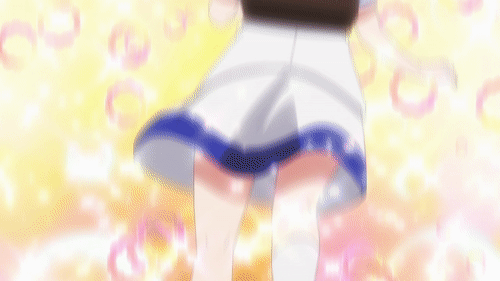
Now we move on to the main plot of the episode, which is Chimame visiting Rize and Sharo’s school. Like I said in the preview, this episode covers chapters 10 and 11 of the volume 5 of the manga, which in-universe occur at the same time. However while it fully covers (and has the same title as) chapter 10, only the first half of chapter 11 is included. So about 2/3 of the episode are dedicated to the story of chapter 10.
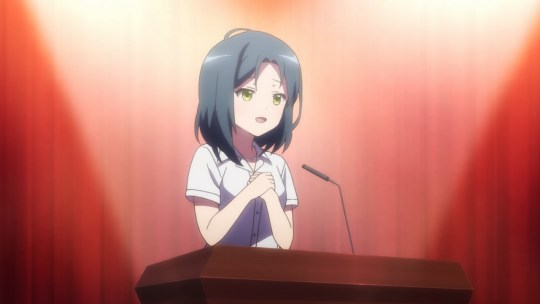
Chimame attend a speech by “OG” Mate Rin. OG in this case doesn’t mean “original gangsta”, but “old girl”, which is a Japanese term for female alumni of some school (there’s also OB for men). Chino recognizes Rin as the editor of Aoyama Blue Mountain, and I’m not sure if Maya and Megu ever met her, so they don’t. When Rin recalls a senior who turned her life around, Chino recalls her chance meeting with Cocoa. In particular the phrase deai ga taisetsu (”chance meetings are to be cherished”) sticks with her. On the other hand, Maya seems to be interested in the fact that Rin was recommended for scholarship. Interestingly in the manga, Maya slept through most of the speech.
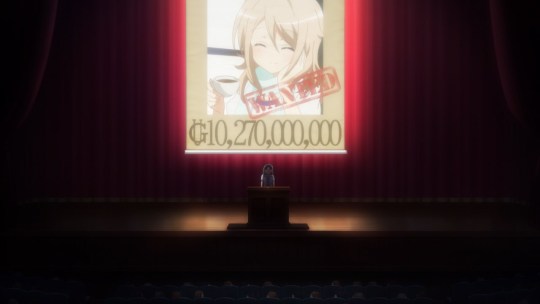
The senior Rin was talking about was obviously Aoyama and we see that there’s actually a huge bounty placed on her. The currency sign consisting of combined letters G and U wasn’t seen before, with prices usually displayed in yen, but there was a Euro-like sign at an open market at the beginning of season 2 episode 1, which might be a shorthand way to write GU. Either way this currency must have a serious hyperinflation problem as the reward for finding Aoyama exceeds 10 billion GU. In countries affected by hyperinflation, a stable foreign currency is often used to perform economic transactions, which might explain why most of the prices are in yen.
But is there some significance to this exact number? Why, yes, 10/27 is Aoyama’s birthday! It is also the start of “reading week”, which actually lasts 2 weeks, until November 9.
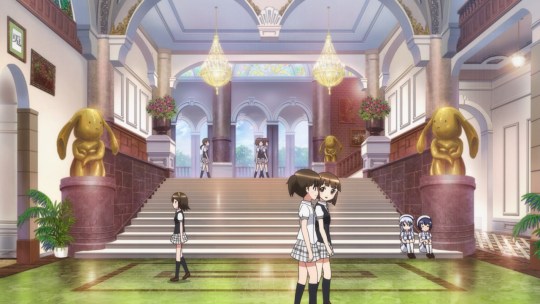
After the speech Megu gets separated from the rest of the group, and the other two also get lost in the vast campus of the school. As seen from the above interior shot of the school, it is also inexplicably rabbit-themed (or maybe just this particular hall is), with golden rabbit statues and also a picture on the left wall with the kanji for rabbit (兎).

Through a series of misunderstandings Chimame end up infiltrating the school with Sharo and Rize providing uniforms for them to blend in. Despite having trouble to behave “ladylike” before, Maya naturally blends in once she treats it as a game, and even gets invited to a tea party. She makes a mistake though by mentioning moyashi (bean sprouts) which is considered a cheap and low-class food, but she’s saved by the fact that the rich girls don’t even know what that is, and Sharo explaining how to prepare it in a fancy way.
Eventually the groups meet each other and Maya reveals she has been recommended for scholarship due to her good grades. Perhaps she also treated her school grades as experience points to gain, as the title of the episode (and the manga chapter) ”The whole world is my experience points” seems to suggest. This is the idea behind a real concept of gamification, by the way.
There’s also a callback to the season 2 episode 8, where Maya asks Rize for advice while Chino and Megu are spying on her. It is worth to rewatch that scene, because it’s full of foreshadowing for this episode. Back then Maya thinks she’s the only one of the three to go to this school, but now she thinks there’s a good chance all three will still go to the same school. Chino doesn’t seem to feel this way though.
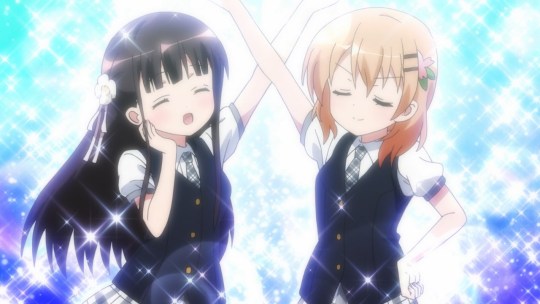
In the end we see Cocoa and Chiya joining the group, also wearing the elite school uniforms, which is briefly explained by them gathering supplies for the cultural festival. I guess the next episode will explain how they ended up there. In the manga even the fact that they have a cultural festival wasn’t revealed until this point. Also in the manga fukiya club president, Karede Yura, inexplicably appears for just one panel so that Cocoa and Chiya could thank her, without any lines. In the anime she appears just as (if not more) suddenly, however there’s some foreshadowing with her inviting Rize to a tournament earlier, and she gets quite a few speaking lines.
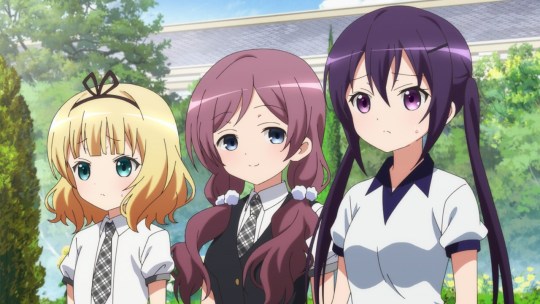
If you listen closely there’s a funny sound effect as she looks at Rize, and then at Sharo. I really liked her design since her first appearance in the manga, and Koi probably does too, as her role has greatly increased in the recent chapters. Consequently her single-panel background appearance has been expanded as well in this episode, she got her full name mentioned in the credits, and there’s even a Karede Yura character song included on the second BD volume (which includes this season’s episodes 3 and 4). All things considered, I fully expect Yura to appear in the episode 4 as well.
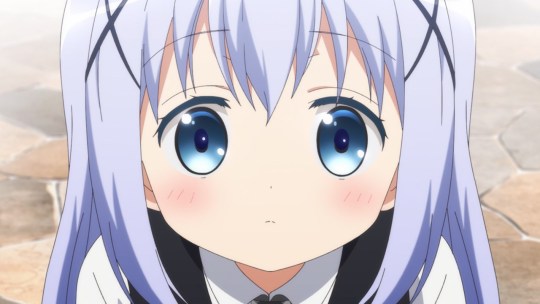
The episode ends with Chino looking at the sky with a worried expression. It just hit her that both Megu and Maya are going to a different school than she is expected to go to. As Megu and Maya have a clear path forward, Chino’s future has become even more uncertain, and she feels like the odd one out in the group. Now the part of the ending where Chino is suddenly alone makes sense:
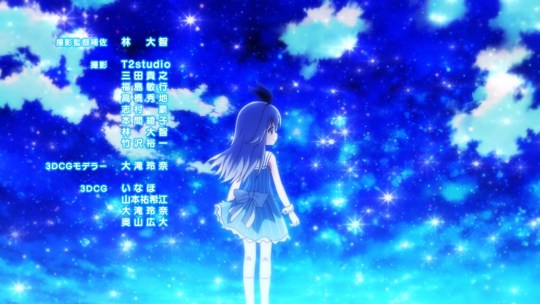
this is basically her imagining the future where Maya and Megu leave her. The coffee cup transition symbolises Chino waking up and seeing that MaMe are still her friends and aren’t going anywhere. We’ll see though...
This time it’s Megu doing latte art in the ending, and the picture is of Chino and Maya dancing. The weird thing is, Megu wasn’t even present at this scene, so how did she draw it in such detail?
Also another random fact I noticed: Chino’s Alice costume actually appeared in the opening of both season 1 and season 2. Here’s a comparison for reference:
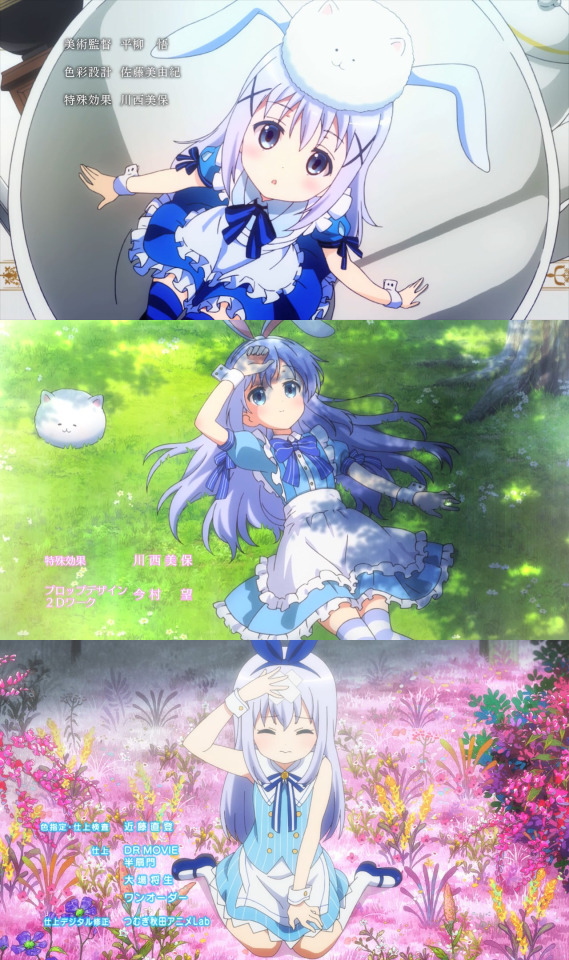
Anyway, that was the third episode of Gochuumon wa usagi desu ka? BLOOM and I hope you enjoyed reading my review. See you next week... or so.
10 notes
·
View notes